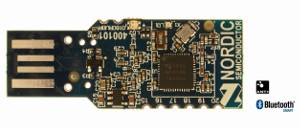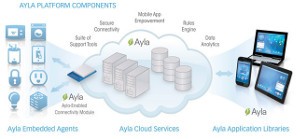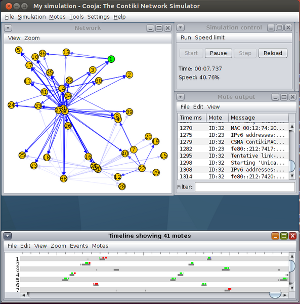During this year’s recent I/O conference, Google announced Brillo, their new operating system targeted at Internet-of-Things applications.
The Brillo OS is a derivative of Android, and be described as a streamlined and cut-down version of Android – targeted towards IoT and smart-home applications on low-power embedded devices with constrained memory and other resources.
According to Google, Brillo is an operating system for the Internet of Things that will connect devices through a communication layer called Weave, which “provides seamless and secure communication between devices, both locally and through the cloud”.
As Brillo is based on the lower levels of Android, you’re likely to be able to choose from a wide variety of hardware platforms and silicon vendors that will be compatible with the Brillo OS. With this all-in-one operating system, you can focus on building your hardware and applications – everything else you need for an end-to-end IoT solution is already built in. Furthermore, Brillo provides a Web-based console for device administration – providing update services, crash reporting and metrics for your devices and making system management inexpensive and accessible.
Brillo provides a kernel, hardware abstraction, connectivity, and security infrastructure within a limited memory footprint, which is ideal for inexpensive and smaller devices. At the time of writing the specific range of supported chipsets and hardware requirements for Brillo are currently unknown, however it has been estimated that it will run on devices with as little as 32 to 64 Mb of RAM – making it a lot more lightweight than regular Android builds.
Furthermore Brillo support is being integrated into the Google mobile platform and Google Play, so support for connectivity to Brillo-equipped devices is built-in to devices (such as smartphones) that run Android, and is easily available for iOS. Android devices will auto-detect Brillo and Weave devices.
It appears likely that Brillo will support wireless communications standards specifically relevant to the IoT market, such as Thread, on supported hardware, along with common Wi-Fi and Bluetooth communications.
For device OEMs, using Brillo means you can build new devices and products quickly and securely, without having to worry about software updates. For other operating systems, you can just add a compatibility library to connect with Brillo devices over Weave.
For app developers, interoperability with Brillo and Weave can extend the reach of your apps to the physical world. You can build one app to control multiple devices in the home and work environments, leveraging Google services such as voice-control actions.
With Brillo, Google is aiming to build an operating system that device manufacturers can put on their devices to ease the process of getting a device online, manage the connectivity and many of the lower-level hardware functions that device manufacturers probably don’t want to deal with.

For end users, Brillo-based and Weave-based IoT applications give users confidence that their connected devices will work with each other, and work with different smartphones and devices. Brillo and Weave promise to make the IoT easy-to-use for end users, since automatic setup, provisioning and easy-to-use sharing is built in.
The second part of Google’s recent announcement concerns Weave – a communications framework for IoT devices that allows different devices to talk to each other. It’s a cross-platform, common language that will let Brillo devices, smartphones and Internet services all talk to each other, addressing the challenge of IoT interoperability.
Weave is cross-platform, and it exposes APIs for developers, making it valuable for OEMs and app developers trying to link their cloud-based services to devices communicating with Weave.
Weave is not a separate protocol, but rather lightweight schema developers can use for standardised and interoperable communications. It provides a common language and vocabulary so that IoT devices can advertise their capabilities to other devices on the network and expose the different functions that they offer, defining certain devices and what they can do.
According to Google, “Weave promises to be “the IoT protocol for everything – from phone to device to cloud”. The idea is to create a standard way for each device in the home or building to explain to the other devices what it’s capable of and what it’s doing right now, so they can all work together as a team.
This functionality that Weave offers appears to be broadly comparable to Apple’s HomeKit system in terms of device discovery, configuration and communication – it’s basically the glue that connects together a bunch of disparate networked devices from different vendors, turning them into a rich system for automation and interoperability.
Furthermore, Google’s Weave program aims to standardise quality and interoperability across different manufacturers through a certification program that device makers must adhere to for their devices to be “Weave Compatible”.
As part of this program, Weave provides a core set of schemas that will enable apps and devices to seamlessly interact with each other. “We want to connect devices in a seamless and intuitive way, and make them work better for users”, according to Sundar Pichai’s announcement at Google I/O.
Brillo and Weave represent a key public development in Google’s offerings in the IoT and home automation market, which has been fairly quiet following last year’s acquisition of Nest Labs. The Nest thermostat and future devices in the Nest ecosystem will also use Weave, so devices from other manufacturers can easily and securely interoperate with these Nest products.
This new development from Google is highly-anticipated by all of us in the Internet-of-Things development community, and the team at LX is ready when you are. Our team of solutions architects, engineers and specialists is ready to partner with you for your success in the IoT marketplace. Getting started is easy – click here to contact us, or telephone 1800 810 124.
LX is an award-winning electronics design company based in Sydney, Australia. LX services include full turnkey design, electronics, hardware, software and firmware design. LX specialises in embedded systems and wireless technologies design.
Published by LX Pty Ltd for itself and the LX Group of companies, including LX Design House, LX Solutions and LX Consulting, LX Innovations.









